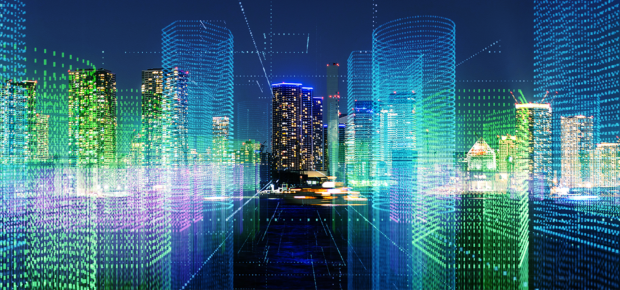September 23, 2019
Last week we shared an overview of the technologies that allow for smart lighting technology. This week, we’re exploring how human beings can benefit from smart lighting in action.
Over four billion people live in urban areas around the globe — approximately 55 percent of the world’s population.1 Increased urbanization over the next several decades, stemming from a variety of socioeconomic factors, has the potential to cause serious problems in energy management and distribution, traffic congestion and more.
To meet the needs of growing urban populations, cities will need to leverage emerging technologies in conjunction with big data to more effectively manage resources and services.
What Are Smart Cities?
Are our cities dumb? No, but they’re not nearly as smart as they could be.
The concept of the smart city has been around for the past several decades, although it’s only recently risen to prominence due to advances in modern technological capabilities. Artificial Intelligence (AI), Machine Learning (ML), the Internet of Things (IoT) and other emerging technologies have made what was once conceptual possible.
“Smart cities rely on technology and data to augment various aspects of urban life,” says Shawn Chandler, IEEE Senior Member. “Physical, institutional, social and technical elements of a city can be improved through the support that emerging technologies provide the public, government bodies and other stakeholders.”
Smart cities focus heavily on improving both the day-to-day and long-term health of urban centers and their inhabitants through improving decision-making capabilities and efficiencies. “Smart cities have the capacity to improve the performance of urban functions, increase awareness and utilization of city resources and advance the overall well-being of citizens,” Chandler added.
Efficient Energy Cities
Densely populated urban centers are major sources of energy demand, as increased populations directly translate to increases in energy consumption. Thus, a central challenge of life associated with increased urbanization is the intelligent and efficient utilization of energy in terms of management, distribution and sustainability.
As Chandler notes, smart cities seem poised to present an intelligent solution to this challenge: “Smart energy production and utilization – the improvement of efficiencies in existing power generation and delivery mechanisms – enables large savings of both energy and money through the reduction of losses.”
According to Chandler, a key enabler of improved energy utilization is the smart grid, an intelligent supply network focused on detecting and reacting to local changes in energy usage. Supported by the IoT, AI, ML and other emerging technologies, the smart grid has the potential to ensure improved efficiencies and sustainability through the continuous monitoring of utilization and distribution patterns.
“The smart grid, supported by advancements in computing coupled with an abundance of data, will enable improved every-day decision-making capabilities,” says Chandler.
Intelligent Illumination
To see the smart grid in action, one need only walk around the neighborhood.
Smart streetlights connected to the broader smart grid are the physical embodiment of the concept of energy efficiency.
IEEE Life Senior Member Raul Colcher says smart streetlights are capable of automatically dimming in the sunlight and brightening when it’s darker, ensuring that electricity is utilized only when needed. These lights are not shackled to the wasteful timer technologies of yesteryear that don’t account for cloud cover and other factors that impact natural lighting.
Furthermore, smart streetlights are an ideal solution to address changing needs due to inclement weather. “Smart public lighting systems utilize sensors, enabling them to provide more favorable lighting during instances of less-than-favorable weather, such as storms with heavy rain, fog, dust storms, blizzards and more,” says Chandler.
In towns and on a local level, smart streetlights can be strategically designed to brighten at night, triggered by the presence of individuals requiring illumination before returning to a dimmer state when no additional lighting is required, further saving energy for when it’s required.
Beyond cost savings, intelligent streetlights can also be programmed to brighten significantly when a presumed altercation is occurring nearby – an effective crime deterrent – while simultaneously alerting law enforcement officials to ensure improved civilian safety.
“Ultimately, smart public lighting can be managed to meet emerging needs of a city’s populace,” says Chandler.
IEEE’s Impact on Smart Lighting
Comprised of the world’s foremost thought leaders in the field, IEEE’s Power & Energy Society (PES) provides the world’s largest forum for sharing the latest in technological developments in the electric power industry, for developing standards the guide the development and construction of energy-related equipment and systems, and for educating members of the industry and the general public on topics pertaining to energy utilization, distribution, sustainability, and more.
1- Population Reference Bureau






 Meaningful Momentum or Running in Place?
Meaningful Momentum or Running in Place? AI Through Our Ages
AI Through Our Ages Liquid Infrastructure: Our Planet's Most Precious Resource
Liquid Infrastructure: Our Planet's Most Precious Resource The Impact of Technology in 2025
The Impact of Technology in 2025 Quantum and AI: Safeguards or Threats to Cybersecurity?
Quantum and AI: Safeguards or Threats to Cybersecurity? Why AI Can't Live Without Us
Why AI Can't Live Without Us Bits, Bytes, Buildings and Bridges: Digital-Driven Infrastructure
Bits, Bytes, Buildings and Bridges: Digital-Driven Infrastructure Impact of Technology in 2024
Impact of Technology in 2024 Emerging AI Cybersecurity Challenges and Solutions
Emerging AI Cybersecurity Challenges and Solutions The Skies are Unlimited
The Skies are Unlimited Smart Cities 2030: How Tech is Reshaping Urbanscapes
Smart Cities 2030: How Tech is Reshaping Urbanscapes Impact of Technology 2023
Impact of Technology 2023 Cybersecurity for Life-Changing Innovations
Cybersecurity for Life-Changing Innovations Smarter Wearables Healthier Life
Smarter Wearables Healthier Life Infrastructure In Motion
Infrastructure In Motion The Impact of Tech in 2022 and Beyond
The Impact of Tech in 2022 and Beyond Cybersecurity, Technology and Protecting Our World
Cybersecurity, Technology and Protecting Our World How Technology Helps us Understand Our Health and Wellness
How Technology Helps us Understand Our Health and Wellness The Resilience of Humanity
The Resilience of Humanity Harnessing and Sustaining our Natural Resources
Harnessing and Sustaining our Natural Resources Creating Healthy Spaces Through Technology
Creating Healthy Spaces Through Technology Exceptional Infrastructure Challenges, Technology and Humanity
Exceptional Infrastructure Challenges, Technology and Humanity The Global Impact of IEEE's 802 Standards
The Global Impact of IEEE's 802 Standards Scenes of our Cyber Lives: The Security Threats and Technology Solutions Protecting Us
Scenes of our Cyber Lives: The Security Threats and Technology Solutions Protecting Us How Millennial Parents are Embracing Health and Wellness Technologies for Their Generation Alpha Kids
How Millennial Parents are Embracing Health and Wellness Technologies for Their Generation Alpha Kids Space Exploration, Technology and Our Lives
Space Exploration, Technology and Our Lives Global Innovation and the Environment
Global Innovation and the Environment How Technology, Privacy and Security are Changing Each Other (And Us)
How Technology, Privacy and Security are Changing Each Other (And Us) Find us in booth 31506, LVCC South Hall 3 and experience the Technology Moon Walk
Find us in booth 31506, LVCC South Hall 3 and experience the Technology Moon Walk Virtual and Mixed Reality
Virtual and Mixed Reality How Robots are Improving our Health
How Robots are Improving our Health IEEE Experts and the Robots They are Teaching
IEEE Experts and the Robots They are Teaching See how millennial parents around the world see AI impacting the lives of their tech-infused offspring
See how millennial parents around the world see AI impacting the lives of their tech-infused offspring Take the journey from farm to table and learn how IoT will help us reach the rising demand for food production
Take the journey from farm to table and learn how IoT will help us reach the rising demand for food production Watch technical experts discuss the latest cyber threats
Watch technical experts discuss the latest cyber threats Explore how researchers, teachers, explorers, healthcare and medical professionals use immersive technologies
Explore how researchers, teachers, explorers, healthcare and medical professionals use immersive technologies Follow the timeline to see how Generation AI will be impacted by technology
Follow the timeline to see how Generation AI will be impacted by technology Learn how your IoT data can be used by experiencing a day in a connected life
Learn how your IoT data can be used by experiencing a day in a connected life Listen to technical experts discuss the biggest security threats today
Listen to technical experts discuss the biggest security threats today See how tech has influenced and evolved with the Games
See how tech has influenced and evolved with the Games Enter our virtual home to explore the IoT (Internet of Things) technologies
Enter our virtual home to explore the IoT (Internet of Things) technologies Explore an interactive map showcasing exciting innovations in robotics
Explore an interactive map showcasing exciting innovations in robotics Interactively explore A.I. in recent Hollywood movies
Interactively explore A.I. in recent Hollywood movies Get immersed in technologies that will improve patients' lives
Get immersed in technologies that will improve patients' lives